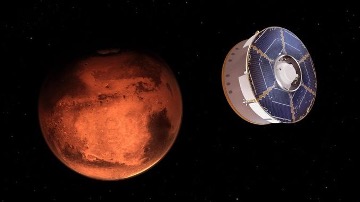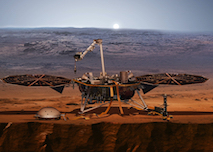News & Updates
5. Opening of the new ground station in Bisdee Tier - 31/01/2022
A new communications antenna that will provide ground support to space missions and reduce the chance of collisions for spacecraft has been unveiled at the University of Tasmania’s Greenhill Observatory. Developed in partnership with the Australian Space Agency, the $2-million antenna was funded jointly by the Australian Government’s Space Infrastructure Fund (SIF) and the University, with the investment designed to help grow the Australian space sector. This new and unique infrastructure will provide local and global partners with the opportunity to conduct activities never before possible in the southern skies.
The University of Tasmania is a leader in space sciences and the only University in the world that operates a continental-scale array of antennas. Professor Simon Ellingsen, Dean of School of Natural Sciences, said the new 7.3-metre antenna 70 kilometres north of Hobart would provide space-to-earth communications for low-earth-orbit satellites. “In the past, we have only been able to listen to transmissions from spacecraft but now we are able to transmit messages through radio frequency communications to spacecraft, sending commands as well as receiving data.”
The new infrastructure is also critical to the development of the field of Space Domain Awareness, which allows ground crews to track spacecraft, like satellites and debris in space. “For the first time we will be able to develop a fully sovereign bi-static radar capability – a more sensitive and accurate form of locating satellites and space-debris – transmitting from the new antenna and receiving reflected signals at other sites across our array, such as the Mt Pleasant observatory 40 kilometres from Bisdee Tier.”
4. Presentation at the IPPW
Modern radio observations of spacecraft allow us to perform a range of different experiments including accurate measurement of the state vectors of spacecraft, studying planetary atmospheres by radio occultation, measuring the effect of gravity on satellites conducting flybys and observing space weather events such as coronal mass ejections and solar wind. In August 2021 Jasper Edwards presented a poster at the 18th International Planetary Probe Workshop (IPPW) titled “EVN Observations of Mars Landers - Enhancing Knowledge of the Martian Interior”. This experiment involved radio telescopes from the European VLBI Network and the University of Tasmania’s array and involved collaboration between the University of Tasmania, Delft University, Joint Institute for VLBI in Europe and the Royal Observatory of Belgium. The Presentation outlined initial results obtained from VLBI radio telescope observations of spacecraft stationed on Mars. The high precision of spatial positioning and multi-station Doppler data obtained in these experiments allows us to reduce the uncertainty of Mars orientation parameters which are strongly linked to the behaviour of the Martian interior.
3. Space Domain Awareness demonstration
Proof of concept for the space domain awarenesss (SDA) capability by the University of
Tasmania
radio telescopes
 2. Tracking the landing of Mars 2020 Perseverance rover
2. Tracking the landing of Mars 2020 Perseverance rover
Mars Perseverance was launched on July 30 2020 and successfully landed in the Jezero Crater of Mars on February 18 2021. The landing was one of the most critical operations, since it had to ensure proper use of parachutes and adjust the velocity of the trajectory accordingly for it descend. Three radio telescopes from the University of Tasmania were used to follow the trajectory of the Mars Perseverance just hours prior to arrive at Mars. From 06:00 to 11:00 pm the spacecraft was visible above the Australian sky and the antennas tracked the motion of the craft during its lasts 500.000 km of the journey. The robot landed on Mars 10 hours later.
 1. Observations of Mars landers - enhancing knowledge of Martian interior
1. Observations of Mars landers - enhancing knowledge of Martian interior
After more than 15 years of development and a number of "live" demonstrations on the Huygens (2005), Smart-1 (2006), Venus Express (2008 - 2014) and Mars Express (2009 - present time) ESA missions, the Planetary Radio Interferometry and Doppler Experiment (PRIDE) is preparing to provide new science capabilities for future missions, including present and future Mars landers. The ed045 proposal call aim to observe NASA's InSight lander, to improve the mission's science return, as well as to prepare for observations of ESA's ExoMars-2020 lander. The high spatial precision and the multi-station Doppler data provided by PRIDE provides a unique opportunity to enhance these missions' science return, specifically our understanding of the Martian interior. This is achieved by the PRIDE-Doppler data's capability to reduce the estimated uncertainty of Mars Orientation Parameters, which are strongly linked to the Martian interior. [Ref source: EVN proposal 0d045]
 0.
New dedicated satellite tracking station
0.
New dedicated satellite tracking station
UTAS-operated space tracking facilities in Tasmania are set to receive a $1.2 million upgrade by the Australia Space Agency, as part of the Space Infrastructure Fund from the Australian Space Agency. The funding will be used to construct new tracking antennas at the University of Tasmania Greenhill Observatory at Bisdee Tiers in the southern midlands, but also to improve the spacecraft tracking capabilities of the five existing radio telescopes. "With the funding we will build two antennas, a 2-3 metre dish that will operate at UHF and S-band," said Dr Molera Calvés. "The antenna will provide ground support for CubeSats, which are small, economic satellites that Universities can build themselves and put it into space." "We will install a larger antenna, with a dish size between 7-9 metres, that will be dedicated for Telemetry, Tracking & Command (TT&C), and data downloading of remote-sensing satellites." The Space Infrastructure Fund is a $19.5 million investment in seven infrastructure projects to build Australia’s space capabilities, including a Mission Control centre located in South Australia. The new antennae will be part of the mission control centre for the Australian Space Agency. So any missions in which Australia participates in the upcoming years, they will use these antennas for ground support of their operations. The location of Tasmania is ideal for its good coverage of polar orbits that many other places on mainland Australia do not have and excel atmospheric conditions. "We have a perfect opportunity to boost the Australian Space Program and the scientific outcome of the University" said Dr Molera Calves. "This infrastructure can provide scientific data, such as remote sensing, faster to the researchers here. And also, characterisation of solar wind and space weather can be done by studying the propagation of the spacecraft signal along the space... [Ref source: internal newsletter publication].